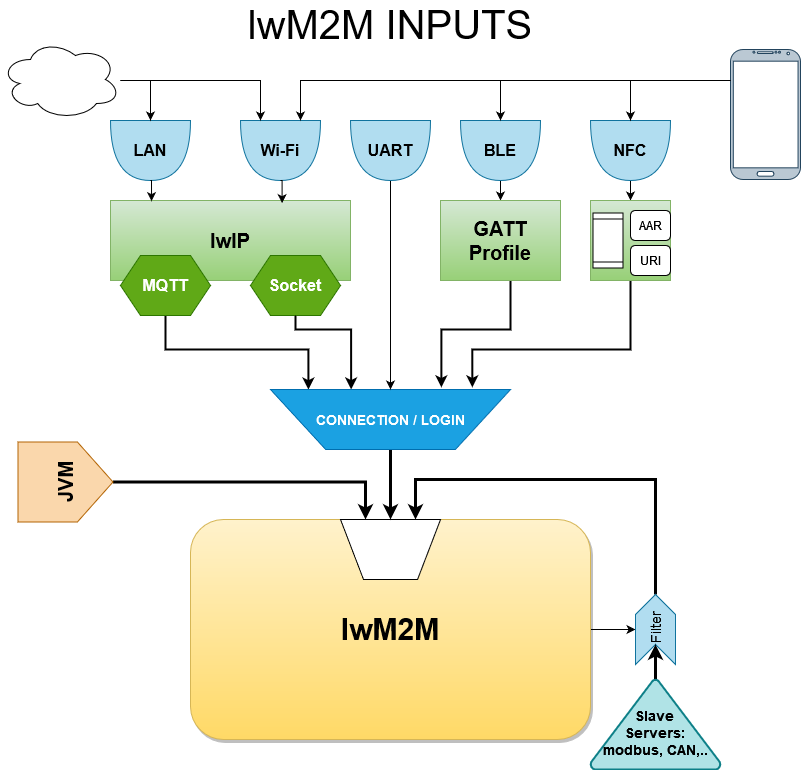RF Incoming protocols

This chapter presents the protocols used to connect a Tap (the lwM2M input) from a remote device:
- RF protocols are normally used from mobile devices (smartphone, tablets, PC)
- Wired protocols (UART) can be used in production (for mass configuration of Taps).
The RF protocols managed by IoTize products are:
- NFC (Near Field Communication)
- BLE (Bluetooth Low Energy)
- Wi-Fi (or LAN)
- LoRa
💡 Note:
- lwM2M commands can also be sent from the internal JVM.
- when a target protocol is configured in slave server mode (modbus RTU/TCP, CAN, SPI), an external master can access some intap variables - and only to authorized intap variables -.
RF protocol comparison
The following table shows the pros and cons of IoTize combined protocol solutions:
| RF solution | Pros | Cons |
|---|---|---|
| NFC-only | Secure, convenient for configuration, cheap, low power (possible energy harvesting) | Must stay in short range |
| NFC-BLE | The cons of each solution are fixed by the combination | No permanent connection (no effective alarm) |
| NFC-WiFi | Permanent connection in station mode (if the network infrastructure provides an internet access). Supports MQTT. | Consumption and radio waves. The client must be connected to the same network |
| NFC-BLE-LoRa | Good combination to take advantage of the low, medium and long range | The LoRa connection is quite slow (low bitrate) |
NFC
NFC is a convenient way to:
- Select the target system,
- Wake up a 'sleeping' target,
- Launch the associated app (stored in the NFC tag or your Tap),
- Securely initiate pairing authentication and encryption mechanisms.
It is available on almost all recent mobile devices (either android or iOS). The 'NFC only' solution is not very convenient for monitoring (the short distance must be kept for the whole exchange). But it is cheap and perfect for 'one-time' configuration (or an unfrequent usage) thanks to the IoTize' 3-stroke method.
BLE (without NFC)
BLE (Bluetooth Low Energy) is the best way to communicate locally with a device:
- Range is between 20m and 60m,
- Low power solution,
- Available on most mobile devices: Android, iOS and Windows (Windows 10).
- Data transfer rate depends on the mobile device (OS, settings, ...) with a maximum of about 2 kilobytes per second.
NFC-BLE
NFC can be considered as the 'perfect companion' for BLE and is used:
- To select the correct device,
- To wake up the target system,
- To avoid a permanent radio emission and thus reduce overall consumption,
- To launch (or retrieve) an app,
- To start BLE to continue the communication,
- To secretly exchange the keys required to secure the subsequent BLE exchanges.
The NFC provides a so called 'out of band' channel for BLE.
WiFi
A family of wireless network protocols. Similar to BLE but, if both BLE and WiFi use a 2.4 GHz band, there are several differences:
- WiFi is generally dedicated to TCP-IP.
- Range, data rate (and Power) are higher for WiFi.
- WiFi supports MQTT publish-subscribe network protocol.
Our WiFi modules support two modes:
- 'Access point' (or 'hotspot'), when they can serve several mobile devices. This mode is very similar to BLE.
- 'Network (Station)', when they are clients connected to an existing network. This provides a permanent connection to servers if the module is connected to the Internet through a local network.
NFC-WiFi
When associated to WiFi, NFC can be used to wake-up the WiFi transceiver, to perform a secure connection (for example to dynamically build and share a WPA key), or to provide the connection data (SSID, IP address, ...).
MQTT
MQTT is an internet protocol that allows remote access. It can be used either directly with Tap supporting WiFi connected to internet through a gateway, or with a mobile phone working as a relay to internet.
LoRa
- LoRa provides another way to connect the module 'almost permanently' to the internet.
- LoRaWan, protocol based on LoRa is also supported.
- It requires a network infrastructure (gateway) but this gateway could be quite far away (typically 10-20km).
- We generally distinguish between private networks (inside a plant for example) and public LoRaWan networks (that work as mobile phone networks).